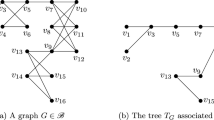Abstract
The Johnson graph \(J(v,k)\) has, as vertices, the \(k\)-subsets of a \(v\)-set \(\mathcal {V}\) and as edges the pairs of \(k\)-subsets with intersection of size \(k-1\). We introduce the notion of a neighbour-transitive code in \(J(v,k)\). This is a proper vertex subset \(\Gamma \) such that the subgroup \(G\) of graph automorphisms leaving \(\Gamma \) invariant is transitive on both the set \(\Gamma \) of ‘codewords’ and also the set of ‘neighbours’ of \(\Gamma \), which are the non-codewords joined by an edge to some codeword. We classify all examples where the group \(G\) is a subgroup of the symmetric group \(\mathrm{Sym}\,(\mathcal {V})\) and is intransitive or imprimitive on the underlying \(v\)-set \(\mathcal {V}\). In the remaining case where \(G\le \mathrm{Sym}\,(\mathcal {V})\) and \(G\) is primitive on \(\mathcal {V}\), we prove that, provided distinct codewords are at distance at least \(3\), then \(G\) is \(2\)-transitive on \(\mathcal {V}\). We examine many of the infinite families of finite \(2\)-transitive permutation groups and construct surprisingly rich families of examples of neighbour-transitive codes. A major unresolved case remains.
Similar content being viewed by others
Notes
That is, each point of \(\mathcal {V}\) lies in a constant number of codewords (\(k\)-subsets) in \({\Gamma }\), but some point pairs lie in different numbers of codewords.
References
Barwick S., Ebert G.: Unitals in Projective Planes. Springer Monographs in Mathematics. Springer, New York (2008).
Borges J., Rifà J., Zinoviev V.A.: On completely regular binary codes and \(t\)-designs. In: Comb01-Euroconference on Combinatorics, Graph Theory and Applications. Electronic Notes in Discrete Mathematics, vol. 10. Elsevier, Amsterdam (2001).
Borges J., Rifà J., Zinoviev V.A.: On non-antipodal binary completely regular codes. Discret. Math. 308, 3508–3525 (2008).
Bray J.N., Holt D.F., Roney-Dougal C.M.: The Maximal Subgroups of the Low-Dimensional Finite Classical Groups. LMS Lecture Note Series. Cambridge University Press, Cambridge (2013).
Cameron P.J.: Permutation Group. London Mathematical Society Student Texts, vol. 45. Cambridge University Press, Cambridge (1999).
Conway J.H., Curtis R.T., Norton S.P., Parker R.A., Wilson R.A.: Atlas of Finite Groups. Oxford University Press, Eynsham (1985).
Delsarte P.: An algebraic approach to the association schemes of coding theory. Philips Res. Rep. (10), vi+97 pp. (1973).
Dickson L.E.: Linear groups: with an exposition of the Galois field theory. With an introduction by W. Magnus. Dover Publications, New York (1958).
Dixon J.D., Mortimer B.: Permutation Groups. Springer, New York (1996).
Durante N.: On sets with few intersection numbers in finite projective and affine spaces. Electronic J. Combin. (to appear).
The GAP Group: GAP-Groups: Algorithms and Programming, Version 4.7.4 (2014). http://www.gap-system.org. Accessed 30 May 2014.
Godsil C.D., Praeger C.E.: Completely transitive designs (1997). arXiv:1405.2176. Accessed 30 May 2014.
Kleidman P.B.: The maximal subgroups of the Chevalley groups \(G_2(q)\) with \(q\) odd, the Ree groups \(^2G_2(q)\), and their automorphism groups. J. Algebra 117, 30–71 (1988).
Kleidman P., Liebeck M.: The Subgroup Structure of the Classical Groups. Cambridge University Press, Cambridge (1990).
Martin W.J.: Completely regular designs of strength one. J. Algebr. Comb. 3, 177–185 (1994).
Martin W.J.: Completely regular designs. J. Comb. Des. 6, 261–273 (1998).
Martin W.J.: Completely regular codes: a viewpoint and some problems. In: Proceedings of 2004 Com2MaC Workshop on Distance-Regular Graphs and Finite Geometry, Pusan, Korea, 24–26 July 2004.
Meyerowitz A.: Cycle-balanced partitions in distance-regular graphs. J. Comb. Inf. Syst. Sci. 17, 39–42 (1992).
Meyerowitz A.: Cycle-balance conditions for distance-regular graphs. In: The 2000 \(\text{ Com }^{2}\)MaC Conference on Association Schemes, Codes and Designs (Pohang). Discret. Math. 264, 149–165 (2003).
Neumaier A.: Completely regular codes. A collection of contributions in honour of Jack van Lint. Discret. Math. 106(107), 353–360 (1992).
Neunhöffer M., Praeger C.E.: Sporadic neighbour-transitive codes in Johnson graphs. Des. Codes Crypt. 72, 141–152 (2014).
Neunhöffer M., Praeger C.E.: Complementary and self-complementary incidence-transitive codes in Johnson graphs (in preparation).
Suzuki M.: On a class of doubly transitive groups. Ann. Math. 75(2), 105–145 (1962).
Taylor D.E.: Unitary block designs. J. Comb. Theory A 16, 51–56 (1974).
Zsigmondy K.: Zur Theorie der Potenzreste. Monatsh. Math. Phys. 3, 265–284 (1892).
Acknowledgments
The project forms part of Australian Research Council Grant DP130100106 of the second author.
Author information
Authors and Affiliations
Corresponding author
Additional information
Communicated by J. H. Koolen.
This paper reports on a joint research project begun in 2005, with written drafts dating back to that year. The research sadly was not finalised before the death of the first author in 2009.
Rights and permissions
About this article
Cite this article
Liebler, R.A., Praeger, C.E. Neighbour-transitive codes in Johnson graphs. Des. Codes Cryptogr. 73, 1–25 (2014). https://doi.org/10.1007/s10623-014-9982-0
Received:
Revised:
Accepted:
Published:
Issue Date:
DOI: https://doi.org/10.1007/s10623-014-9982-0




